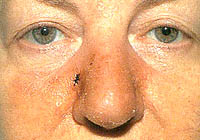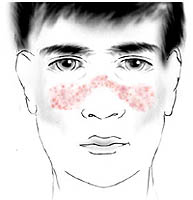Red lupus is an unsuccessful chronic inflammatory disease, named so on the characteristic redness of the skin, resembling, as they thought, traces on the skin after the wolf bites. Hence the Latin name of this disease - Lupus Erythematosus: Lupus - Wolf, Erythema - Redness.
Content
 Skin, systemic and... ordinary
Skin, systemic and... ordinary
Red lupus has nothing to do with an ordinary (tuberculous tuberculosis) - a rare form of tuberculosis, leading to the formation of typical reddish-brown knots on the skin.
Red lupus is manifested by a variety of symptoms and proceeds either in the skin form - discoomed red lupus (DKV), or with the damage in the internal organs in the form of systemic red lupus (SC).
With DKV on the skin (in most cases, on the face and other open parts of the body available to sunlight), characteristic rounded raised plaques with redness and peeling, in the center of which are often scarring; Internal organs, as a rule, are not amazed.
SLE - disease of rheumatic nature, t.E. refers to the same group of diseases as rheumatoid arthritis. In the SLE, severe lesions of the joints, skin, nervous system, kidneys and other internal organs are possible. Skin changes may be the same as during DKV, or manifest itself redness and rash on the cheeks in the form of a characteristic «Butterflies on the face». However, often the skin remains normal.
The red lupus is basically young women. Among the patients with DKV Semeren out of ten - women aged about 30 years and older. Among the patients with SD nine out of ten - women, and at half of them, the first symptoms of the disease appear between 15 and 25 years.
The cause of the DKV is unknown, as is the cause of 90% of the cases of SC. In 10%, it seems to be a side effect of drugs, such as plosenamide (novocainamide), which is prescribed during cardiac arrhythmia.
It is assumed that the red lupus has an autoimmune origin, t.E. caused by special type allergic reactions, in which antibodies (autoantibodies) are produced in the patient's body, as if he was vaccinated against himself. The causes of such allergic reactions remain unclear.
In the SLE, there are damage to the leukocyte parts and nuclear components (nucleoproteins) are released from them, undergoing certain changes in blood plasma. This nuclear material absorbed by other leukocytes changes their properties, turning into the so-called LE cells (LE - from Lupus Erythematosus).
Apparently, autoantibodes, directed against the nuclear material of their own tissues and called antinuclear (anti-tenant) act similarly. In this regard, during the diagnosis of the SLE, LE cells and anti-klear autoantibodies detect, and also determine the number of certain serum proteins, the content of which falls in the active phase of the autoimmune disease.
Skin rashes can be treated with creams or ointments containing sunscreen and corticosteroids. In pronounced skin manifestations, highly efficient antimalarial drugs. More active corticosteroid therapy, in particular, the appointment of prednisone inside, is used mainly when defeating internal organs, but it helps and under skin manifestations.
Many sick wells in a weakly pronounced or wave-like current form are able to lead a normal lifestyle. The duration of the disease depends on its severity and on which organs are preferably amazed. The cause of death most often serve irreversible kidney lesions and infection. Starting from the mid-50s as a result of constant improvement of treatment methods, the life expectancy of patients with HVE has grown far.









